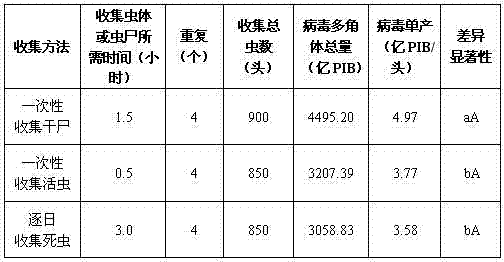A kind of production method of tea caterpillar nuclear polyhedrosis virus
A technology of nuclear polyhedrosis and production method, which is applied in the production field of tea caterpillar nuclear polyhedrosis virus, can solve the problems of affecting the feeding amount of larvae, death of overwintering eggs, and easily broken virus carcasses, so as to reduce the infection of tea caterpillar virus The probability of hair growth, the effect of ensuring the amount of virus production, and ensuring the amount of larva rearing
- Summary
- Abstract
- Description
- Claims
- Application Information
AI Technical Summary
Problems solved by technology
Method used
Image
Examples
Embodiment 1
[0019] Put the potted tea tree into an insect cage (length 55cm×width 55cm×height 90cm, plastic gauze), insert 100-150 pairs of adult tea caterpillars, let them mate in the cage, and lay eggs on the back of the leaves. The insect cages are placed outdoors or indoors at natural temperature for overwintering.
[0020] After the eggs hatch, cut off the leaves with worms and put them in canning jars. One egg mass per bottle is added to several pieces of old leaves for feeding, and the mouth is tied with paper, and the cover glass is used to keep moisture. When most of the leaves in the bottle are eaten, remove the debris in time and add new leaves. When the larvae grow to the 4th instar, move the larvae in the bottle to a wooden box, about 1000-1500 worms per box, add tea branches with old leaves to raise, and cover the box with a wet towel and glass to moisturize.
[0021] When the larvae grow to the middle stage of the 6th instar, the poisoning treatment is carried out. The m...
Embodiment 2
[0025] After the adults start to emerge, put the canned bottle containing the tea caterpillar pupae into the insect cage (30cm×46cm×55cm, plastic gauze), open the paper cover of the bottle mouth, 3 bottles per cage, and place two in the cage at the same time. Bundle the tea branches cultivated in water, let the adults mate and lay eggs.
[0026] After the eggs hatch, cut off the leaves with worms and put them in canning jars. One egg mass per bottle is added to several pieces of old leaves for feeding, and the mouth is tied with paper, and the cover glass is used to keep moisture. When most of the leaves in the bottle are eaten, remove the debris in time and add new leaves. When the larvae grow to the 4th instar, move the larvae in the bottle to a wooden box, about 1000-1500 worms per box, add tea branches with old leaves to raise, and cover the box with a wet towel and glass to moisturize.
[0027] When the larvae grow to the middle stage of the 6th instar, the poisoning tr...
PUM
 Login to View More
Login to View More Abstract
Description
Claims
Application Information
 Login to View More
Login to View More - R&D
- Intellectual Property
- Life Sciences
- Materials
- Tech Scout
- Unparalleled Data Quality
- Higher Quality Content
- 60% Fewer Hallucinations
Browse by: Latest US Patents, China's latest patents, Technical Efficacy Thesaurus, Application Domain, Technology Topic, Popular Technical Reports.
© 2025 PatSnap. All rights reserved.Legal|Privacy policy|Modern Slavery Act Transparency Statement|Sitemap|About US| Contact US: help@patsnap.com

